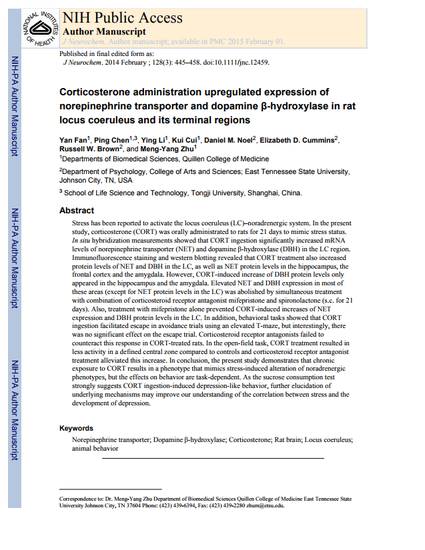
Stress has been reported to activate the locus coeruleus (LC)-noradrenergic system. In this study, corticosterone (CORT) was orally administrated to rats for 21 days to mimic stress status. In situ hybridization measurements showed that CORT ingestion significantly increased mRNA levels of norepinephrine transporter (NET) and dopamine β-hydroxylase (DBH) in the LC region. Immunofluorescence staining and western blotting revealed that CORT treatment also increased protein levels of NET and DBH in the LC, as well as NET protein levels in the hippocampus, the frontal cortex and the amygdala. However, CORT-induced increase in DBH protein levels only appeared in the hippocampus and the amygdala. Elevated NET and DBH expression in most of these areas (except for NET protein levels in the LC) was abolished by simultaneous treatment with combination of corticosteroid receptor antagonist mifepristone and spironolactone (s.c. for 21 days). Also, treatment with mifepristone alone prevented CORT-induced increases of NET expression and DBH protein levels in the LC. In addition, behavioral tasks showed that CORT ingestion facilitated escape in avoidance trials using an elevated T-maze, but interestingly, there was no significant effect on the escape trial. Corticosteroid receptor antagonists failed to counteract this response in CORT-treated rats. In the open-field task, CORT treatment resulted in less activity in a defined central zone compared to controls and corticosteroid receptor antagonist treatment alleviated this increase. In conclusion, this study demonstrates that chronic exposure to CORT results in a phenotype that mimics stress-induced alteration of noradrenergic phenotypes, but the effects on behavior are task dependent. As the sucrose consumption test strongly suggests CORT ingestion-induced depression-like behavior, further elucidation of underlying mechanisms may improve our understanding of the correlation between stress and the development of depression.
Available at: http://works.bepress.com/russell-brown/33/

This is the peer reviewed version of the following article: Journal of Neurochemistry 2013; 123(3): 445-458 (10.1111/jnc.12459) from PMC, which has been published in final form at https://doi.org/10.1111/jnc.12459. This article may be used for non-commercial purposes in accordance with Wiley Terms and Conditions for Self-Archiving.